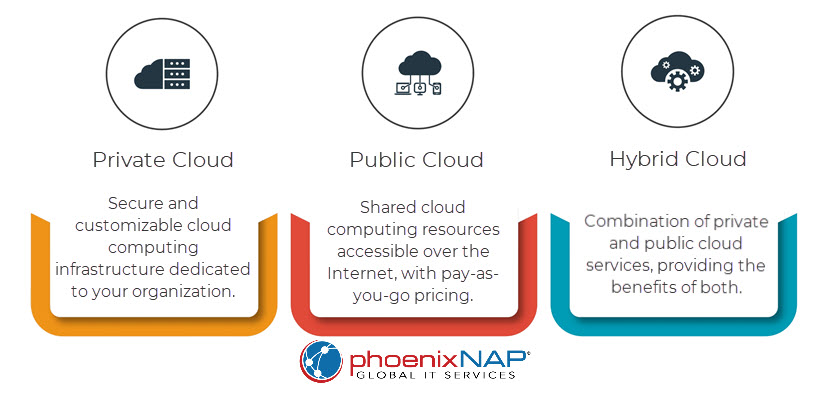Modern organizations must balance innovation and agility with security and control. Traditional IT infrastructures often struggle to meet these demands and accommodate rapidly changing workloads.
A hybrid cloud solves this issue by seamlessly integrating the public cloud's flexibility and scalability with the private cloud's security and control. By combining these two solutions, businesses can overcome their limitations and achieve optimal performance.
This article explores hybrid cloud adoption, outlines implementation strategies, and highlights the benefits of this method.
What Is Hybrid Cloud Adoption?
Hybrid cloud adoption involves integrating public and private cloud services with on-premises infrastructure to create a cohesive IT system. This approach enables organizations to distribute workloads across different environments based on their requirements for security, compliance, performance, and cost.

Components of Hybrid Cloud
The components below work together to create a hybrid environment.
- Public cloud infrastructure. This component includes a range of cloud services offered by third-party providers, including Infrastructure as a Service (IaaS), Platform as a Service (PaaS), and Software as a Service (SaaS). Key characteristics of the public cloud include elasticity, pay-per-use pricing, and a broad spectrum of services like compute, storage, networking, and databases.
- Private cloud infrastructure. This component refers to IT resources dedicated to a single organization, often managed on-premises or in a colocation facility. Private clouds provide greater control, security, and compliance adherence than public clouds. Virtualization, containerization, and software-defined infrastructure are commonly used technologies with this type of infrastructure.
- On-premises infrastructure. This component incorporates legacy systems, applications, and hardware residing within an organization's data centers. Although these components are essential for modernization, they remain critical for business operations and must be integrated into the hybrid cloud environment.
- Hybrid cloud management platform. This software layer orchestrates and manages resources across disparate environments, ensuring seamless integration and workload mobility. Key functionalities include resource provisioning, monitoring, automation, and governance.
- Data management and integration. This component focuses on data consistency, replication, and synchronization across various cloud environments. It includes data integration tools, data lakes, and data governance policies to ensure data accessibility and reliability.
- Connectivity and networking. This component refers to the infrastructure that enables communication between public, private, and on-premises environments. Virtual private networks (VPNs), software-defined wide area networks (SD-WANs), and network virtualization technologies are crucial for establishing secure and efficient connections.
- Security and compliance framework. A robust security architecture is essential for protecting sensitive data and meeting regulatory requirements. This component includes identity and access management, data encryption, threat detection, and compliance certifications.

Hybrid Cloud Adoption Strategies
Here is a detailed roadmap to guide your hybrid cloud adoption process:
1. Assess Current Infrastructure
Before starting your hybrid cloud journey, you must understand your existing IT infrastructure. This assessment will help identify strengths, weaknesses, and areas for improvement.
Inventory Existing Systems
The first step in assessing the current infrastructure is conducting a thorough inventory of existing systems.
- Document all servers, storage devices, network equipment, and other hardware components.
- Identify all applications, databases, and software tools in use.
- Catalog all data assets, including their types, locations, and usage patterns.
Evaluate Performance
Identify areas for improvement.
- Measure current system performance using metrics like response time, throughput, and availability.
- Find performance bottlenecks.
- Assess resource utilization to identify underused or overused components.
Identify Gaps
Determine where you need improvements and how a hybrid cloud strategy could address these gaps.
- Identify vulnerabilities and areas where security can be improved.
- Determine if current systems meet regulatory and compliance requirements.
- Identify areas where current systems do not meet business needs.
2. Define Business Objectives
Aligning your hybrid cloud strategy with your organization's goals and objectives is crucial for driving overall success.
Engage Stakeholders
Engaging stakeholders is the first step in aligning your hybrid cloud strategy.
- Determine the individuals and groups that will be impacted by the hybrid cloud adoption, including IT leadership, business unit heads, and end users.
- Gather input on business objectives, technology needs, and concerns through interviews, workshops, and surveys.
- Capture each stakeholder group's needs and expectations to ensure they are addressed in the hybrid cloud strategy.
Define Risk Tolerance
Defining your organization's risk tolerance is essential for balancing the benefits of hybrid cloud adoption with potential risks.
- Identify risks associated with cloud adoption, such as data breaches, compliance violations, and service outages.
- Establish clear, acceptable levels of risk in areas like security, compliance, and financial impact.
- Develop strategies to mitigate identified risks, such as deploying additional security controls or selecting cloud providers with strong compliance support.
- Continuously monitor risk levels and adjust the cloud strategy to maintain alignment with the organization's risk tolerance.
Prioritize Needs
Focus on the most critical aspects of hybrid cloud adoption that will deliver the greatest business impact.
- Determine the primary drivers for hybrid cloud adoption, such as the need for scalability, cost reduction, or improved performance.
- Apply a structured framework, such as MoSCoW (Must have, Should have, Could have, and Won't have), to prioritize needs based on their impact on business outcomes.
- Direct resources towards the highest-priority initiatives, ensuring that critical areas like security, compliance, and performance receive adequate attention.
- Evaluate immediate needs and long-term strategic goals to ensure the hybrid cloud strategy addresses both effectively.
3. Conduct a Cost-Benefit Analysis
A thorough cost-benefit analysis will help justify the investment and ensure the benefits outweigh the costs.
Calculate Costs
Estimate the costs associated with migrating workloads to the hybrid cloud environment.
- Calculate ongoing operational costs, including cloud service fees, maintenance, and support.
- Identify potential hidden costs, such as data transfer fees, integration costs, and training expenses.
Identify Benefits
Quantify potential cost savings from reduced capital expenditure, improved efficiency, and optimized resource utilization.
- Estimate performance improvements, such as faster response times, increased availability, and enhanced scalability.
- Identify strategic benefits, such as improved agility, innovation, and competitive advantage.

4. Develop a Migration Plan
A well-structured migration should outline the steps, timelines, and resources required for the migration.
Phased Approach
Breaking down the process into manageable stages to minimizes disruption and ensures a smooth transition.
- Start with a pilot phase to test the hybrid cloud environment with a small set of workloads.
- Plan iterative migration phases to gradually move workloads to the hybrid cloud environment.
- Develop a rollback plan to revert to the previous environment if issues arise.
Pilot Projects
Test the hybrid cloud environment and gather insights to inform subsequent migration phases.
- Choose pilot projects based on their potential impact, complexity, and risk.
- Document lessons learned from pilot projects to inform subsequent migration phases.
- Define success metrics to evaluate the performance and effectiveness of pilot projects.
5. Ensure Security and Compliance
Security and compliance are critical to any hybrid cloud adoption strategy.
Data Protection
Implement robust security measures to protect sensitive information and ensure only authorized users can access data.
- Implement encryption for data at rest and in transit to protect sensitive information.
- Establish robust access control mechanisms to ensure only authorized users can access data.
- Deploy intrusion detection systems to monitor and respond to security threats.
Compliance Requirements
Ensure the hybrid cloud environment meets all relevant regulatory requirements, such as GDPR, HIPAA, or PCI-DSS.
- Implement audit trails to track and document all data access and management activities.
- Obtain necessary compliance certifications to demonstrate adherence to industry standards.
6. Implement a Governance Framework
A robust governance framework should include policies, procedures, and controls to ensure compliance with security and regulatory requirements.
Policy Development
Create policies for data management, access control, and incident response to ensure the security and compliance of the hybrid cloud.
- Develop policies for data classification, storage, retention, and disposal.
- Establish policies for user authentication, authorization, and access control.
- Define policies for incident detection, response, and recovery.
Monitoring and Auditing
Implement tools and processes to continuously monitor the hybrid cloud environment for security threats and performance issues.
- Implement continuous monitoring tools to detect and respond to security threats and performance issues.
- Generate audit reports to document compliance status and identify areas for improvement.
- Conduct regular audits to assess compliance with governance policies and regulatory requirements.

7. Select the Right Cloud Providers
The right cloud providers must meet the organization's technical, security, and compliance requirements.
Vendor Evaluation
Assess potential cloud providers based on their capabilities, security measures, and service level agreements.
- Evaluate potential cloud providers based on their technical capabilities, service offerings, and innovation roadmaps.
- Assess the security measures and certifications of potential cloud providers.
- Review service level agreements (SLAs) to ensure they meet the organization's performance and availability requirements.
Integration
The selected cloud providers should seamlessly integrate with existing systems and applications.
- Verify that cloud providers offer robust API support for integration and automation.
- Consider a multi-cloud strategy to leverage the strengths of multiple cloud providers and avoid vendor lock-in.
phoenixNAP’s hybrid cloud solutions deliver scalable infrastructure, top-tier security, and seamless integration. With robust SLAs and extensive API support, we are the perfect partner for your cloud journey. Contact us to learn more.
8. Train and Educate Staff
Ensuring staff members have the necessary skills and knowledge to manage the hybrid cloud is crucial for its success.
Skills Development
Encourage staff to enhance their skills in hybrid cloud technologies.
- Develop training programs to educate IT staff on hybrid cloud technologies, best practices, and management tools.
- Encourage staff to obtain relevant certifications to enhance their skills and knowledge.
Change Management
Change management involves the following steps:
- Develop a change management plan to facilitate the transition to the hybrid cloud environment.
- Address resistance to change by involving stakeholders in the planning process and addressing their concerns.
- Communicate the benefits and implications of the hybrid cloud strategy to all stakeholders.
9. Optimize Workload Placement
Placing workloads in the most suitable environment enhances performance, security, and cost-efficiency.
Workload Analysis
Assess workloads to determine their requirements and place them in the most suitable environment.
- Analyze workload performance to determine their response time, throughput, and availability.
- Assess the security requirements of workloads to place them in an appropriately secure environment.
- Evaluate the compliance requirements of workloads to ensure that they meet regulatory standards.
Performance Monitoring
Implement monitoring tools to continuously track the performance of workloads across the hybrid cloud environment.
- Define performance metrics to measure the effectiveness of workload placement.
- Adjust workload placement based on performance data and changing business needs.
10. Implement Disaster Recovery and Business Continuity
Disaster recovery and business continuity solutions are essential for the availability and resilience of the hybrid cloud. You should design them to minimize downtime and data loss in the event of a failure.
Backup Solutions
Develop a backup strategy to ensure that all critical data is regularly backed up.
- Implement backup tools to automate the backup process and ensure data integrity.
- Conduct regular backup testing to verify the effectiveness of backup solutions.
Redundancy
Implement redundant systems to ensure that critical workloads continue to operate in the event of a failure.
- Deploy failover mechanisms to automatically switch to backup systems in the event of a failure.
- Define recovery time objectives (RTO) to ensure that critical workloads can be restored within acceptable timeframes.
11. Leverage Automation and Orchestration
Automation and orchestration tools significantly enhance the efficiency of managing a hybrid cloud. These tools streamline workflows, reduce manual effort, and improve performance.
Automation Tools
Use Infrastructure as Code tools to automate the provisioning and management of hybrid cloud infrastructure.
- Implement configuration management tools to automate the configuration and deployment of applications.
- Use scripting languages to automate repetitive tasks and streamline workflows.
Orchestration
Implement workflow orchestration tools to manage complex workflows across the hybrid cloud.
- Use service orchestration tools to automate the deployment and management of services across multiple cloud providers.
- Define policies to automate the orchestration of workloads based on predefined rules and conditions.
Automation is a powerful tool for streamlining operations and eliminating repetitive tasks. However, implementing automation in complex IT environments often requires orchestration.
Discover how orchestration and automation can transform your IT operations by reading our in-depth article.
12. Continuous Improvement
Regularly reviewing and refining the hybrid cloud strategy maximizes its benefits and addresses emerging challenges.
Feedback Loop
Establish mechanisms to gather feedback from users on the performance and usability of the hybrid cloud environment.
- Collect feedback from stakeholders to understand their needs and expectations.
- Analyze feedback to identify areas for improvement and prioritize enhancements.
Iterative Improvement
Collect and analyze performance data to identify trends, patterns, and areas for improvement.
- Use iterative development methodologies to continuously refine the hybrid cloud strategy based on feedback and performance data.
- Encourage exploring new technologies and methods to enhance the hybrid cloud.

What Are the Benefits of Hybrid Cloud Adoption?
Here are some the key advantages of adopting a hybrid cloud strategy:
Cost Optimization
Hybrid cloud reduces capital expenditure by leveraging public cloud services. Instead of investing heavily in on-premises hardware, organizations can leverage the scalable resources public cloud providers provide. This approach allows businesses to avoid the significant upfront costs of purchasing and maintaining physical infrastructure.
Also, the hybrid cloud offers pay-as-you-go pricing models that align costs with actual usage. This model allows organizations to only pay for the resources they consume, which can lead to substantial cost savings. During periods of low demand, businesses can scale down their cloud usage and reduce costs. Conversely, during peak periods, they can scale up to meet increased demand without incurring the high costs of maintaining excess capacity.
For example, an ecommerce platform can automatically scale its web servers during a holiday sale to handle increased traffic and then scale back down once the sale ends.
Scalability
One of the most compelling advantages of a hybrid cloud is its elasticity. Organizations can handle peak loads by leveraging public cloud services without needing extensive on-premises infrastructure. This scalability is crucial for businesses that experience fluctuating demand.
A hybrid cloud also offers the flexibility to adapt to changing business needs by quickly provisioning or de-provisioning resources. This agility allows organizations to respond swiftly to market conditions, new opportunities, or unexpected challenges.
For instance, a startup can quickly scale its IT infrastructure to support rapid growth without significant upfront investments in hardware.
Flexibility
A hybrid cloud allows optimal workload placement, enabling organizations to choose the best environment for each workload based on specific requirements. For example, mission-critical applications that require high availability and low latency can be hosted in a private cloud. In contrast, less critical applications can be hosted in the public cloud to take advantage of cost savings.
Moreover, the hybrid cloud enables the customization of private cloud environments to meet specific business requirements. Organizations can tailor their private cloud infrastructure to support unique workloads, compliance needs, or security protocols.
For instance, a healthcare provider can design its private cloud to meet stringent data privacy regulations while benefiting from the scalability and cost advantages of the public cloud for non-sensitive workloads.
Legacy System Integration
Hybrid clouds can accommodate legacy systems that may not be suitable for migration to the public cloud. Many organizations have critical applications and systems that have been used for years and are deeply integrated into their operations. These legacy systems often require specific hardware or software configurations that are not easily replicated in a public cloud environment. Organizations can use a hybrid cloud to keep these legacy systems on-premises while benefiting from the public cloud's scalability and flexibility for other workloads.
For example, a financial institution can maintain its legacy mainframe systems on-premises while using the public cloud for newer, more flexible applications.

Hybrid Cloud: The Best of Both Worlds
Organizations can achieve a more agile, cost-effective, and secure IT infrastructure that supports their business goals and operational needs by adopting a hybrid cloud strategy. The hybrid cloud model enables businesses to leverage the strengths of different computing environments to meet their specific requirements for security, compliance, performance, and cost.



